Sales: How to start and how to communicate with customers
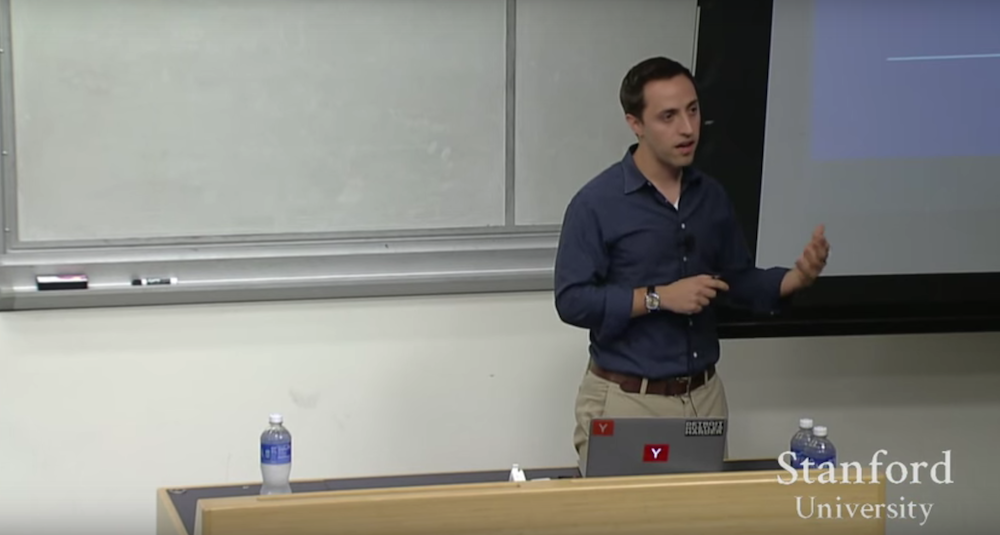
Stanford course CS183B: How to start a startup . Started in 2012 under the leadership of Peter Thiel. In the fall of 2014, a new series of lectures by leading entrepreneurs and Y Combinator experts took place:
Second part of the course
First part of the course
- Sam Altman and Dustin Moskovitz: How and why to create a startup?
- Sam Altman: How to form a start-up team and culture?
- Paul Graham: Illogical startup ;
- Adora Cheung: Product and Honesty Curve ;
- Adora Cheung: The rapid growth of a startup ;
- Peter Thiel: Competition - the lot of losers ;
- Peter Thiel: How to build a monopoly?
- Alex Schulz: An introduction to growth hacking [ 1 , 2 , 3 ];
- Kevin Hale: Subtleties in working with user experience [ 1 , 2 ];
- Stanley Tang and Walker Williams: Start small ;
- Justin Kahn: How to work with specialized media?
- Andressen, Conway and Conrad: What an investor needs ;
- Andressen, Conway and Conrad: Seed investment ;
- Andressen, Conway and Conrad: How to work with an investor ;
- Brian Cesky and Alfred Lin: What is the secret of company culture?
- Ben Silberman and the Collison Brothers: Nontrivial aspects of teamwork [ 1 , 2 ];
- Aaron Levy: Developing B2B Products ;
- Reed Hoffman: On Leadership and Managers ;
- Reed Hoffman: On the leaders and their qualities ;
- Keith Rabois: Project Management ;
- Keith Rabua: Startup Development ;
- Ben Horowitz: Dismissal, promotion and reassignment ;
- Ben Horowitz: Career advice, westing and options ;
- Emmett Shire: How to conduct interviews with users;
- Emmett Shire: How to talk to users in Twitch ;
- Hossein Rahman: How hardware products are designed in Jawbone;
- Hossein Rahman: The Design Process at Jawbone.
Tyler: Thanks for the invitation. My name is Tyler, and today I want to talk about sales. I am the CEO of Clever. At university I studied mathematics and statistics, and then it seemed to me that finance is my vocation. I was going to create my own hedge fund, but at the last minute my friend persuaded me to join his startup and start selling sales, about which I knew practically nothing.
')
I had to learn everything along the way. For two years I studied sales at the stage of company formation. After that, I founded Clever along with two excellent technicians focused on product development. We wanted to create a product for schools, but it seemed to me that my experience was not suitable for this. As a result, it turned out that the sales experience that I received in my previous work led to a super-fast growth of the company.
A few words about the company Clever. We develop software for schools. We launched our development platform about two years ago, and today it is used in almost every fifth school in the United States.
So it turned out that sales became the basis of our company. I want to share with you what helped me personally on this difficult path. Of course, that there are millions of ways to conduct sales, so I believe that everyone will find something for themselves.

To begin, talk about your attitude to sales. Many consider selling something supernatural. Many people think that sales people are incredibly smart and charming and can convince any customer. So I used to relate to sales. I believe that many founders hold the same opinion, because they often say: "Now we will start developing our product, and when we finish, we will hire sales specialists."
I realized that the real “sales person” must be the founder. Paul Graham often says that the founder at the stage of becoming a company must do two things: either communicate with users or develop a product. So, communication with users is sales.
This fact scares many people, as they usually say: “I have never been in sales and I don’t even know where to start.” But it turns out that the founder has special advantages that can help him succeed in sales. The first is the love of the product being developed. The second is knowledge of the market and the problem that he is trying to solve. I believe that these advantages are more important than any sales experience.
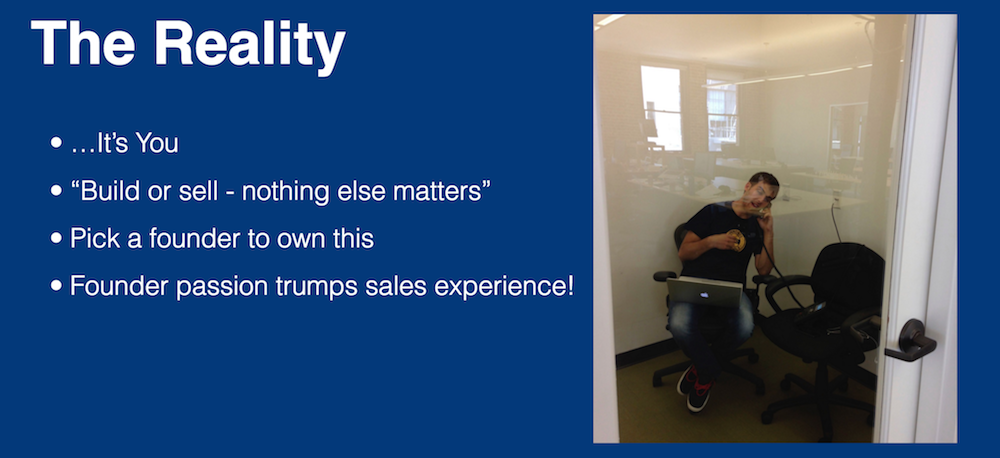
The slide shows how one of our founders communicates with the customer. This is how sales look at the stage of the formation of a startup. Not at all like Don Draper. The basis of sales, as a rule, are frequent calls to customers. Any founder with no sales experience can handle it if he takes all the responsibility on himself. At Clever, we decided that I would be engaged in sales on an ongoing basis, as they are very important for our business.
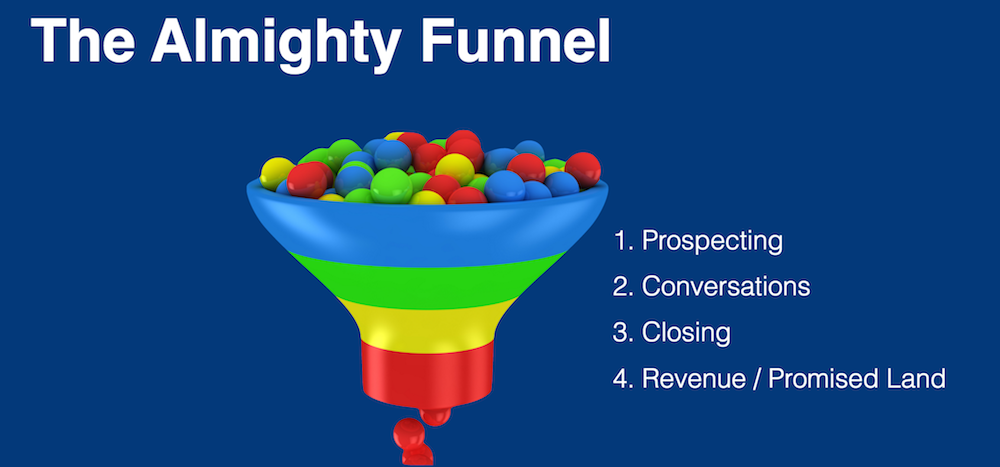
So, now I will tell about what I learned during my work. Everyone knows what a conversion funnel is. It consists of four stages, and your goal is to “skip” your customers through this funnel. At the initial stage, you are looking for the first buyers who are only interested in your product so far. Then you begin to communicate with them regularly - this is the second stage of the funnel. After that, you see who is already ready to purchase your product, come to an agreement with them and make a deal. And then you guarantee yourself a stable income.
I believe that I should tell you more about each stage and strategies that Clever’s success has brought. I will share with you those lessons that we have learned for ourselves and which you can use to work on your project.

In the first stage, you try to figure out who, in principle, will answer your calls. An American scientist named Everett Rogers proposed a model for the life cycle of a new product. This model is presented in the form of a curve, on which five groups of consumers are marked: innovators who try everything new; early followers; early majority; later majority; and latecomers.
Personally, I understood the whole essence of sales at an early stage in the development of a startup precisely because of the indicators that he calculated for the tail of the curve. Innovators, which are located on the left side of the curve, are your potential customers. Some immediately give up when they find out that only 2.5% of companies are potential customers - only 2.5% of companies can think about buying something from a startup that has neither users nor sales revenue.
However, I found that this approach can be quite useful. When you know that only 2.5% of companies will respond to your calls, or at least think about purchasing your product, you begin to understand how important the numbers are. When you are just starting to sell your product and are trying to achieve a rate of 2.5%, you gradually understand how many calls you need to make. You have to communicate with a huge number of people.
That was my work at the stage of becoming Clever. In the first two months of our work with YC, I tried to reach more than 400 companies and talk to them about our product.
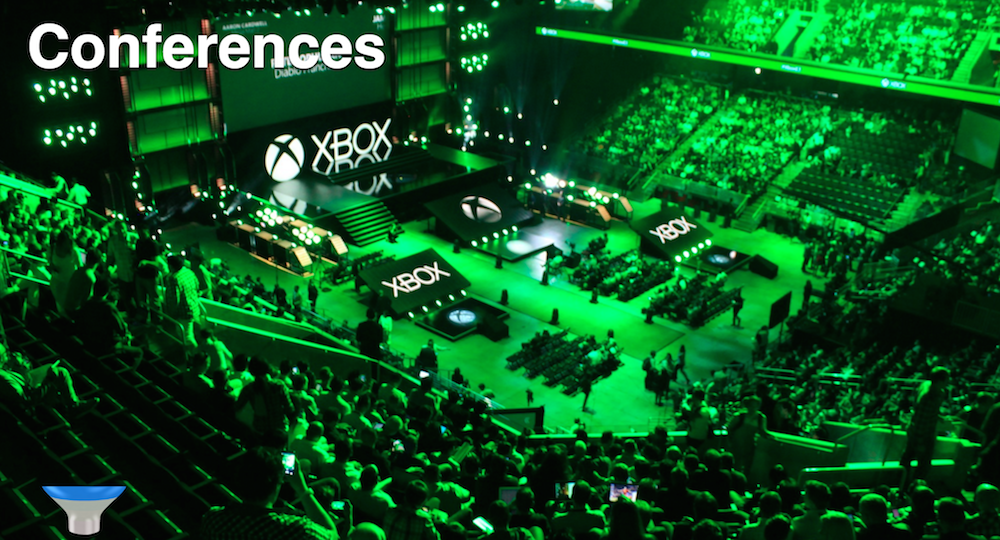
For us, the following three were the most successful methods for finding and attracting potential customers. The first is to search for clients among their acquaintances. This is obvious, so here I am not explaining anything. The second is the search for potential buyers at various conferences: for many it turned out to be a discovery. And the most famous way is “cold” mailing.
When I talk about conferences, everyone usually represents CES or E3. Conferences where you can really find potential clients look quite modest. At the first stage, we often attended such conferences, since we had to be where our potential buyers were. If you want to offer your product to IT managers of companies, and find out that some of them are going to a hotel in Milwaukee, then you should be there too.

We received lists of conference participants in advance, contacted each of them by mail and tried to meet with them. So during the conference we didn’t waste any time. It is worth noting that we met all our first customers at such conferences.
I mentioned the "cold" mailing list. Few people know how to properly send emails. In fact, it is not so difficult: the main thing is not to write a lot. Your message should be short and clear. I had my own scheme - you can do the same.
At the beginning of each letter I talked a little about myself and my company. Then about the product we are working on. After that, I wrote that I would like to talk about him in more detail, and offered to meet in person. The scheme is very simple, and it can be adapted to anyone you want to offer your product. If you find out to whom you should send such letters, then it will be enough for you to send several messages.

This is the search for potential customers. It plays a very important role, since you must first overcome the first stage of the conversion funnel.
Next, you must get a potential buyer to answer your call. Here, the founders also have a lot of questions about what to do. The main thing that needs to be done after you have phoned a potential client is to shut up. This is one of the most important tips in my presentation. People find it hard to believe.
Many of their founders, whom I helped compile a commercial offer, acted as follows. When they called up a person who was ready to discuss their product, they began to praise what they had been working on for so long. They wanted to tell about all its possibilities and tried to prove that their product is the best in the world. I also sometimes have such a desire. It always happens when you are proud of something.

If you listen to the best sales experts talking on the phone, then wonder how little they say. One of these experts told me that he himself tries to speak 30% of the time, while the remaining 70% gives to his interlocutor. Such people ask a lot of questions, for example: “Why did you decide to answer my call? Our product solves this problem - how do you solve it now? How do you imagine the perfect solution to this problem? ”They do not speak for themselves.
They are trying to find out what the person wants, and to understand his problem more deeply. That is how you need to deal with sales. I say this to every Clever employee. This phase of the transaction is very important. By how much you said, you can already tell whether you can make a deal or not. So try to listen more and try to understand the problem of your potential customers.
Another important aspect of this stage, unexpected for many, is that you must constantly keep in touch with your customers. To do this, you must perform several actions: write a letter; then, if you have not received a reply, write another letter; call; leave a voice message. To make a deal, you may need to perform fifty such actions.

The list on the slide is not a collection of random actions: this is the second deal Clever has made. There are a number of unpleasant moments in this list that we had to go through. I sent a letter to the client - he did not answer me. I again sent him a letter - he again did not answer. Then I sent him a letter again. And this man really wanted to buy our product.
Looks stupid, right? I often saw how the founders who successfully talked with the client on the phone, sent a letter and did not receive a response. After that, they began to think that the person was simply not interested in their product. The bottom line is that you must be ready to constantly keep in touch with a potential client and try to make a deal with him.
It is worth adding that when creating your company, every second of yours is worth its weight in gold. Time is your most important resource. You will not be able to chat with anyone who could purchase your product. Therefore, your task is to hear “Yes” or “No” from the client as quickly as possible. Problems begin when a thousand people say you "Maybe."
Some founders boast that they have formed a queue of a hundred people who have shown interest in the product. Such uncertainty can ruin you. In some cases, “No” may be better than “Maybe.” So at least you will move on and devote more time to those who can say yes to you.
Thus, you need to not only achieve your goals and regularly communicate with your customers. You have to make sure that you spend time only on the most important.
So, you talked to a large number of people. You called everyone who needed to call. You keep in touch with them. Now they understand that it’s not easy to get rid of you and you need to sign an agreement. In the end, you need to do something that you did not do before: both sides begin to make their own changes in the text of the contract. It is not as difficult as it seems.

First, you give the agreement to the client, and his lawyers make changes to the document. After that, your lawyers make their changes. Then the process is repeated. If you are part of YC, then your task is simplified, since YC has sample paperwork that you can use. If you do not work with YC, you will have to understand all the documents yourself.
I am glad that YC decided to make all samples of their documents publicly available. Therefore, everyone who is going to engage in sales in his startup, now has one less problem. However, at this stage, another difficulty may arise. Some founders sometimes forget what their goal is. Your goal is to sign several contracts, make your clients a number of well-known companies, wait for their consent and receive a certain income. If you do not do this, your startup will not live long.

I am surprised that quite reasonable people sometimes change the minor details of an agreement ten times, for example, because of their pride. You just need to make sure that your contract meets the requirements of both parties, sign it and proceed to the following tasks. I have seen some founders spend a month reaching an agreement on the issue of protection against liability. They would have achieved much better results if they had just signed the documents and moved on to the next deal. This is the first mistake you can make.
Another mistake that the founders often make arises in a situation where their potential customer says: "I would purchase your product if it had one more function." Many of the founders, especially the most goal-oriented, think that if they add another function to their product, the customer will definitely buy it.
The problem is that this almost never happens. If someone tells you that he would like to purchase your product, but it lacks one function, I would advise not to deal with such customers. In nine cases out of ten, if you add the function they need and again refer to them, they will ask you to add another function or find another reason for which they will not use your product.
In this situation, I would have done differently. I could say "Great! Then let's sign a contract that states that we will introduce an additional function. ” In this case, if you fulfill the client's request, then both will be the winners. But usually in such a situation, our company says: “Good. We will add this function, but only if it is in demand from other buyers. ” If quite a lot of customers contact you with such a proposal, then it needs to be implemented. As a result, you will not need to fulfill orders of individual buyers.
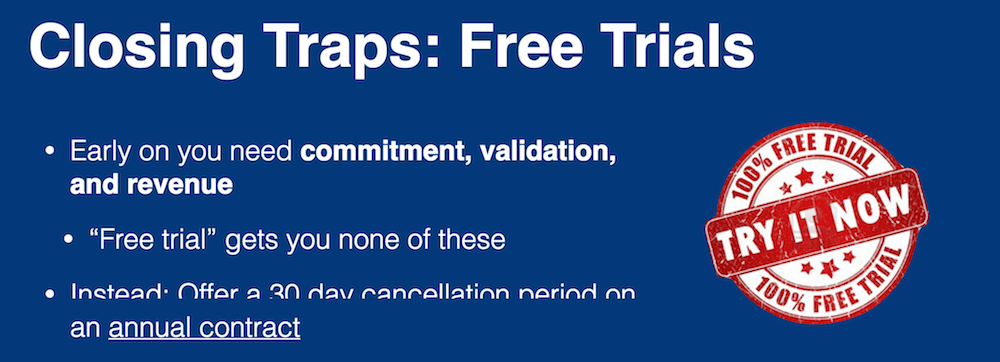
Another pitfall to avoid is the provision of a free trial. A joyful buyer may ask you: “Can I use the trial version?” They have nothing to blame. This request is fully justified. The problem is that if you recently launched your startup, you now need real income and real users who are ready to pay for your product. The trial version does not give either one or the other. If the result of your work is a trial version, then you should understand that you have not advanced as far as you think. You think that you are on the right track, but after the trial version expires, you again have to sell your product. Personally, I acted as follows.
If the client wanted to use the trial version of our product, I said: “We do not provide trial versions. We sign a contract for one year, and if you don’t like something for the first 30 or 60 days, you can refuse our service. ” So you get everything you need, and customers are happy that they can safely use your product. This minor change can play a very important role for your business.
So, you have defined your target audience. You talked to a lot of people. You have made several deals. You have made the necessary changes to the terms of the agreement. You figured out the trial versions. It is time to first sales.
First you need to submit the sales process as the next stage in the development of a startup. At first, you do not need to scale sales. Moreover, you can specifically start selling small volumes to try to get your first buyers. This is quite an interesting experience.
It is also important to remember that after your first sales you need to catch some patterns. What aspects of sales will you scale? Christoph Janz wrote an excellent post on how to create a company worth five million dollars.
He talks about how to get 1,000 people to buy a product worth $ 100,000, how to get 10,000 people to buy a product worth 10,000 dollars, and how to make 100,000 people buy a product worth $ 1,000. On the first day, you may not know which group you belong to, but as a rule, most companies can be attributed to one of these three groups.
If you want to fall into the first category with a product worth $ 100,000, you will have to approach each client individually. To do this, you can use the services of Salesforce and Workday. If you are going to sell your product for $ 1,000, while the paperwork takes you, say, three months, you probably should reconsider your sales process.

I am faced with a large number of startups that are going to launch an inexpensive product, but don’t think about how to scale. This can lead to the fact that you go broke or you have to raise the prices of your goods.
After a series of first sales, it is very important to ask yourself: “At what price should I sell my product in order for my business to remain competitive?”
, , . , , , , , 50 .
, . , , , . , , .
 Announcement:
Announcement:C 17 19 (-, , 2).
. , :)
Source: https://habr.com/ru/post/297728/
All Articles